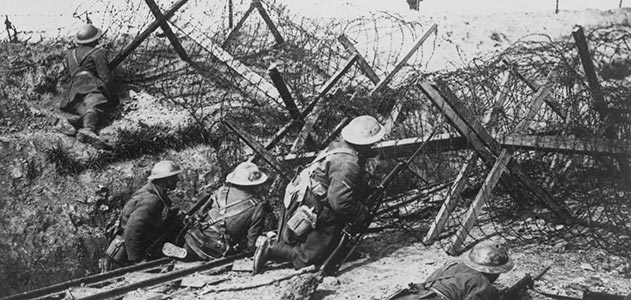British Commander Reasons, High Losses Bring Victory,
Means Equal Losses for the Germans.
Special to The Great War Project
(9-12 July) The blood-letting on the Western Front at the Somme shows no sign of ending.
Although the British five-day artillery bombardment does cut through some of the German barbed wire defenses, it is not so thorough and clean as the British commander, Field Marshall Douglas Haig, would prefer.

British barbed wire defenses, date and place uncertain.
In the meantime, the Germans work furiously to replace their damaged front line wire. “The Germans’ best weapon remained barbed wire,” writes historian Adam Hochschild. “They were bringing 7,000 tons of it up to the front every week, in long rolls stacked on railway cars two layers high.”

German machine gun unit at the Somme, July 1916.
“And both sides were using tough new types of wire, some of which had a sharpened prong every inch or two.”
Reports Hochschild, “As fighting continued, the gains were minimal – a half mile here, a few hundred yards there, and in some places nothing at all.”
But Haig’s optimism and belief in his plan does not waver.
Despite the shocking carnage of the Battle at the Somme, it appears the battle does achieve – albeit to a limited extent – its primary mission, according to Hochschild, “to relieve the pressure on the French at Verdun.”
But despite the diminished threat to Verdun, “Haig doggedly, unyieldingly sent out order after order for more attacks at the Somme.”
These would continue “for an astonishing four and a half months.”
Haig believes that high casualties are a valuable measure of success or failure. In Haig’s mind, he “trumpeted the Somme as successful…because of what it was costing the Germans in dead or wounded.”
Haig reasons that if British losses are high, then German losses must be equally high.

British wounded at the Somme.
“This perverse logic,” reports Hochschild, “sometimes led Haig to fly into a rage when he thought British losses – and so by association German ones – were too low.”
So Haig continues to issue orders sending wave after wave of British soldiers into the maelstrom of battle. “What made it so easy for Haig to demand high casualties was that he chose not to see them.”
He “felt that it was his duty to refrain from visiting the casualty clearing stations,” writes his son, “because these visits made him physically ill.”
Haig is “clearly…uninformed of how great the casualties had been,”
,,,writes war historian John Keegan, “and discussed, as a serious proposition, how the offensive was to be continued, as if it were a possibility for the morrow or the day afterward.”
“Haig believes,” reports Keegan, “that the enemy has undoubtedly been severely shaken and has few reserves in hand.”

German soldier at the Somme, summer 1916.
In fact, according to Keegan, “the Germans had brought up several reserve divisions during the day, while the losses suffered by their troops in the line – about six thousand altogether – were a tenth of those of the British.
For the British, the battle of the Somme is nothing less than a disaster. And the British forces are led by a commander who believes he must repeat again and again the same attacks that bring so much senseless pain and death to his troops.

Mike – Congratulations on reminding us of the true costs of war.- alex